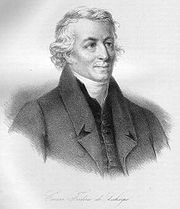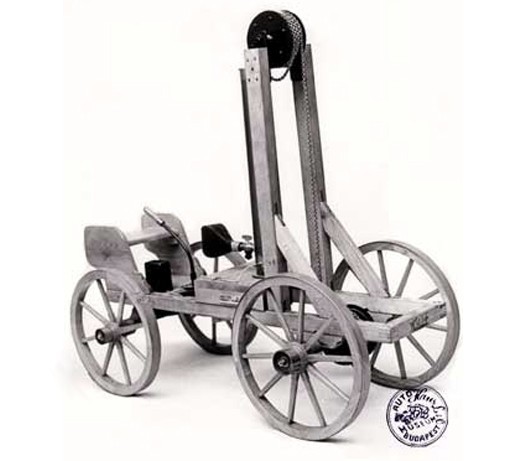<Back to Index>
- Member of Parliament and Inventor François Isaac de Rivaz, 1752
PAGE SPONSOR


François Isaac de Rivaz (Paris, December 19, 1752 – Sion, July 30, 1828) was a French politician, chancellor, Deputé (Member of Parliament), entrepreneur and inventor. In retirement, as a Swiss citizen, circa 1807, he invented a hydrogen powered internal combustion engine with electric ignition. In 1808 he fitted it into a primitive working vehicle - 'the world's first internal combustion powered automobile'.
François Isaac was born in Paris to a family from central Valais in the Savoy. In 1763 the family settled in Moutier in the canton of Bern in Switzerland. The last two boys, Anne Joseph and Isaac came to settle in St. Gingolph in Valais. It is not known at which schools he studied, but he became fluent in Latin plus mastering mathematics and geometry, whilst continuing his study of mechanics throughout his life. He qualified as both a surveyor and notary.
He served as an officer in the French army from 1775, where he was trained in the functions of firearms and artillery. He also studied the ignition of combustible gases.
Isaac had many interests plus an intuitive and extremely curious mind which was driven by the demon of discovery. His experimental work was overflowing. He also experimented with steam powered vehicles in the late 18th century.
After retirement from the Army, living in Switzerland, he invented a primitive internal combustion engine which he constructed in 1807. It
was powered by a mixture of hydrogen and oxygen manually ignited by
electric spark, but the engine neither involved the in-cylinder
compression, the crank, nor the connecting rod. A year later, Isaac built an early automobile for his new engine to power. His engine was never commercially successful.
Coincidentally, in 1807 Nicéphore Niépce installed his 'moss, coal - dust and resin' fueled Pyréolophore internal combustion engine in a boat and powered up the river Saone in France to be granted a patent by the Emperor Napoleon Bonaparte. The discrete, virtually simultaneous, implementations of these two designs of internal combustion in different modes of transport means that the de Rivaz engine can be correctly described as 'the worlds first use of an internal combustion engine in an automobile (in 1808)', whilst the 'Pyréolophore (in 1807) was the world's first use of an internal combustion engine in a ship'.
Although de Rivaz's early work is credited as the first use of the internal combustion engine in an automobile, the further development and mass production of the invention never truly began until the late nineteenth century.
In 1824, the French physicist Nicolas Léonard Sadi Carnot scientifically established the thermodynamic theory of idealized heat engines. This highlighted the shortcoming of these pioneering designs, whereby they needed a compression mechanism to increase the difference between the upper and lower working temperatures and potentially unlock sufficient power and efficiency. Gasoline was not used for internal combustion engines until 1870 when carburetors were invented to convert non - combustible liquid fuels into a combustible gaseous mixture form.